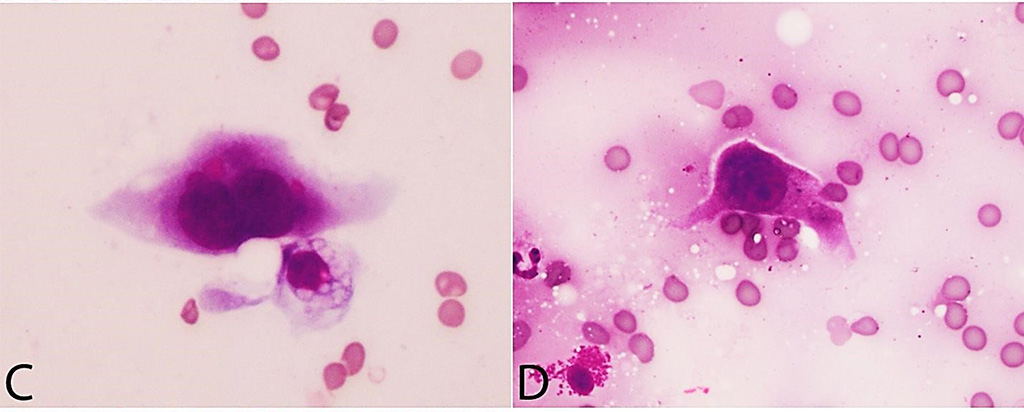Reactive Pneumocytes Identified by Distinctive Cytology
By LabMedica International staff writers
Posted on 15 Apr 2020
One of the most challenging and exceedingly common diagnostic dilemmas in pulmonary pathology is the distinction between reactive and neoplastic epithelial atypia. In particular, reactive pneumocytes in various infectious or inflammatory lung diseases can exhibit marked cytological atypia, which can closely resemble malignancy.Posted on 15 Apr 2020
Various types of acute and subacute lung injury can cause severe reactive pneumocyte atypia, which may mimic malignant proliferations and present a major diagnostic pitfall. This particularly applies to cytological preparations and frozen sections, where background inflammatory injury may be subtle or not apparent.

Image: Touch preparation smears from cases of various forms of lung injury with reactive pneumocytes, illustrating markedly enlarged and highly atypical epithelial cells retaining distinctive Napoleon hat–like shapes (Photo courtesy of Natasha Rekhtman, MD, PhD).
A pathologist at the Memorial Sloan Kettering Cancer Center (New York, NY, USA) has written that the most severe reactive pneumocyte atypia occurs in florid diffuse alveolar damage, where in the organizing phase, hyaline membranes are associated with markedly atypical pneumocytes. Key morphologic features of reactive pneumocytes in acute/subacute lung injury include marked cytomegaly, prominent nucleoli, and chromatin irregularities (clumping or clearing). Macronucleoli, of the type seen in melanomas or viral cytopathic effects, can be present. Nuclear contours may become focally irregular, but tend to remain smooth. Overdiagnosis of reactive pneumocytes as in adenocarcinoma is well documented in the literature. Some reactive pneumocytes have dense cytoplasm, which may also mimic squamous cell carcinoma.
Of particular note was one under recognized but extremely helpful cytomorphological clue to reactive pneumocytes in acute/subacute lung injuries is their highly distinctive shape, characterized by an elongated/pinched outline with a flat surface on one side and a convex surface with protruding nucleus on the opposite side. The flat surface corresponds to the area where the pneumocytes are plastered against the alveolar wall, whereas the convex surface corresponds to the area protruding into the airspaces. Even though the relationship of reactive pneumocytes to alveolar walls is usually not evident in dispersed cytological preparations or may be obscured in frozen sections and some small biopsies, this distinctive shape of reactive pneumocytes tends to be preserved in such specimens.
This shape evokes the look of Napoleon Bonaparte's iconic headwear; the bicorne (2-cornered) hat, thus prompting the proposed term of a “Napoleon hat” sign. Unlike reactive proliferations, the Napoleon hat shapes are only rarely encountered in carcinomas. Although lepidic adenocarcinomas do feature rows of neoplastic pneumocytes growing along alveolar walls, those cells characteristically have cuboidal/hobnail rather than elongated/pinched shapes.
Notably, Napoleon hat shapes tend to be well preserved in direct smears from fine-needle aspirates and touch preparations of core biopsies, whereas in bronchioloalveolar lavage fluids, cells tend to get rounded off, and this feature appears to be more subtle, but still evident in some cells. In frozen section and small biopsies, Napoleon hat shapes may also provide a useful clue to a reactive nature of epithelial atypia. The study was published in the April 2020 issue of the journal Archives of Pathology & Laboratory Medicine.
Related Links:
Memorial Sloan Kettering Cancer Center














